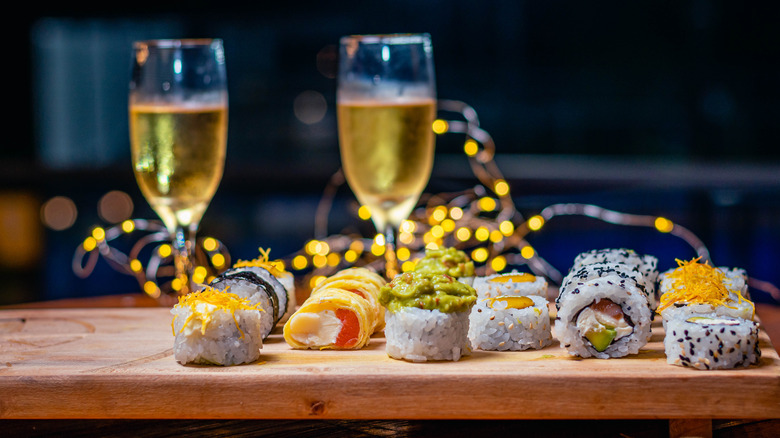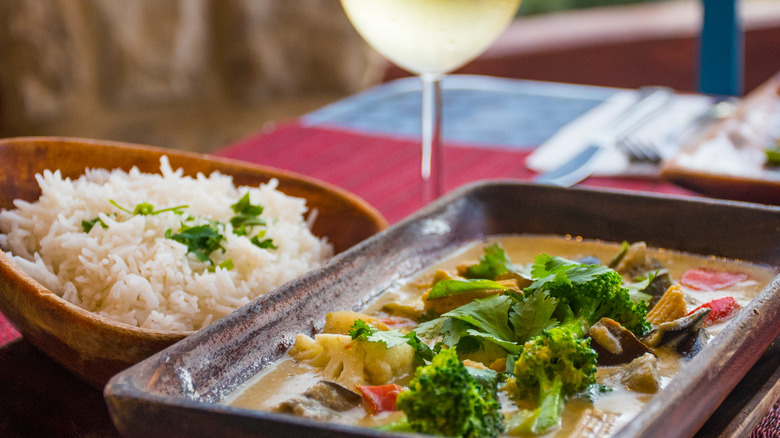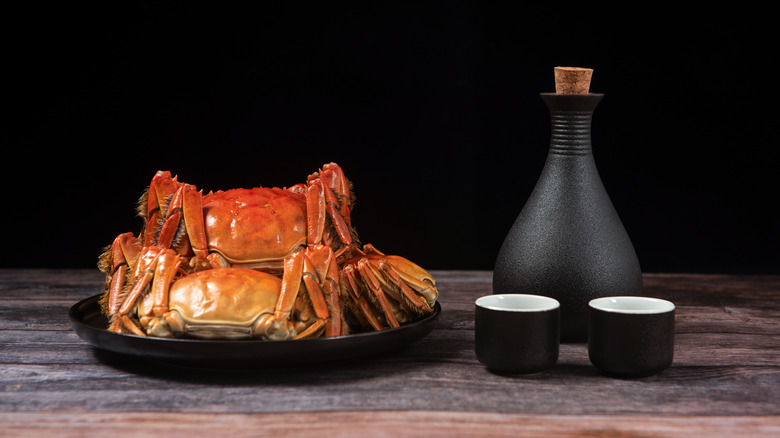The Best Wines To Pair With Different Asian Foods
Asian food is often stereotypically perceived as very spicy. But the culinary flavor spectrum is extremely diverse in Asia, and a variety of unique regional ingredients and techniques sets Asian cuisines apart from, say, traditional French cooking, where fixtures like creamy sauces and mirepoix have helped define Western wine choices. Michelin Guide explains that countries like Thailand don't have an inherent wine culture or prioritize pairing alcoholic beverages with specific meals. Forbes adds that Asian alcohols tend to be made from grains, not grapes. Yet this opens up a whole new horizon of possibilities where adventurous eaters can break away from the old "red wine with red meat, white wine with white meat" adage.
Any classically trained sommelier can rattle off classic choices to drink with your bouillabaisse or boeuf Bourguignon — you actually cook it with red wine (per CNN Travel). But what bottle do you reach for when staring into the flames at a Korean bulgogi restaurant or gazing across a steaming bowl of Vietnamese pho? Can a wine be friends with a complicated curry or an intricate ramen? The answers, as it turns out, are open-ended. The consensus is to choose light-to-medium wines on the mellower side that will highlight the intricately layered flavors of Asian food without taking precedence.
Keep it light and simple
Michelin Guide reports that with their subtly acidic taste, orange wines go well with tamarind-heavy Thai foods and medium dry rieslings or even champagne is best for complexly seasoned preparations like curries where sweeter, more full-bodied wines would eclipse their intricately layered flavors. Likewise, Vinepair writes that sour, off-dry rieslings help counterbalance heat and richer meats like Vietnamese pork. Michelin adds that dry reds like grenache and syrah complement soy and oyster sauces; syrah, grenache, and other moderately acidic, mildly tannic wines are nice with hot foods like kimchi.
Light whites like riesling, pinot gris, and bubbly or fruity pinot noirs and Beaujolais are recommended for Japanese ramen with its rich, salt-forward broths, according to WineEnthusiast. Continuing the theme, Forbes points to effervescent wines for sushi and sashimi alongside tart whites like riesling, chardonnay, sauvignon blanc, and chenin blanc that elevate the fresh, straightforward flavors of raw seafood. They caution eaters to stay away from bolder wines with high alcohol and tannin concentrations as they'll interfere with the taste of the fish and wasabi — and recommend pinot noir or Beaujolais for solid and oily selections.
Start with sake and Shaoxing wine
In conclusion, Asian food and wine pairings should focus on letting the unique flavors of the cuisine breathe. Gentle and dry to slightly sweet reds and whites work with hot and umami. In contrast, the berry notes, minerality, and tacit acidity of middle-ground reds are welcome with savory sauces, fatty meat, and seafood dishes. As Forbes reminds us, stay away from assertive, tannin-heavy wines, opting instead for lean palate-cleansers with low alcohol levels to ensure the enjoyment of every expertly executed bite.
If you find all the wine jargon daunting, you can always accompany your meal with sake, a super-friendly, mild Japanese rice spirit. China Wine Competition explains that its amino acids bring out umami flavors, and Webstaurant Store names examples like sushi, cheese, ramen, and fried dishes. Shaoxing or Chinese rice wine, per Woks of Life, can be enjoyed as a warmed beverage or used for marinating, deglazing, and seasoning sauces, fillings, and more. Be aware that, as with other cooking wines, only the highest-quality versions should be sipped. Try recipes like sake steamed salmon, Korean marinated short ribs, or Cantonese sticky rice to dip your toes into this vast new gastronomical frontier.


